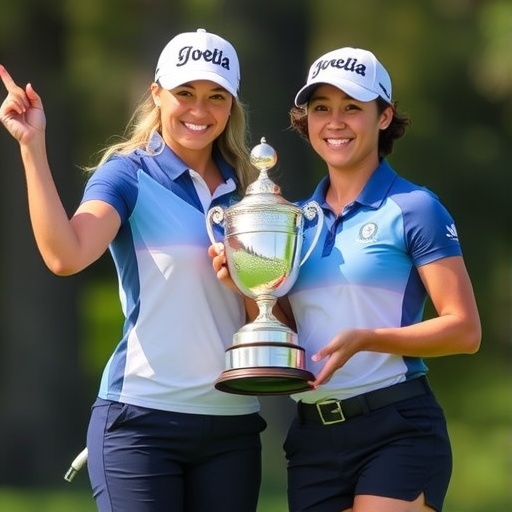Australia Secures Historic First LPGA International Crown Victory Over USA: Minjee Lee and Hannah Green Lead the Charge
In a thrilling finale that captivated golf fans worldwide, Australia clinched its maiden LPGA International Crown title on Sunday, edging out the powerhouse United States in a tense team showdown at Tulsa Country Club. Minjee Lee and Hannah Green emerged as the dynamic duo behind the triumph, combining for a dominant performance that marked a watershed moment for women’s golf Down Under.
The LPGA International Crown, a biennial team event that pits national squads against one another in a format blending individual brilliance with collective strategy, saw Australia dethrone the defending champions. With the final scoreline favoring the Aussies by a narrow yet decisive margin, this victory not only ends years of near-misses for the Australian team but also signals the rising global influence of Australian talent in the LPGA circuit.
The tournament, which kicked off on October 10 and spanned four days of high-stakes match play, featured eight nations vying for supremacy. Australia’s path to glory was paved with resilience, as Lee and Green navigated challenging courses and formidable opponents, ultimately securing four-and-a-half points in the decisive matches against the USA.
Minjee Lee’s Birdie Blitz Ignites Australia’s Comeback
Minjee Lee, the Western Australian sensation and a two-time major champion, was the undisputed star of the show. Entering the final day with Australia trailing slightly in the overall standings, Lee turned the tide with a birdie frenzy on the front nine of her singles match against USA’s Nelly Korda. Her precision irons and unflappable putting—sinking a crucial 15-footer on the 7th hole—propelled her to a 3-up lead midway through.
“It’s surreal,” Lee said post-match, her voice laced with emotion as she clutched the team trophy. “Winning the International Crown for Australia feels like bringing home gold for the nation. We’ve dreamed of this for so long.” Lee’s stats from the tournament were staggering: she carded seven birdies across her two matches, maintaining a scoring average of 68.5, the lowest among all players. Her performance wasn’t just about numbers; it embodied the grit that has defined her career, from her breakthrough LPGA win in 2018 to her 2022 U.S. Women’s Open triumph.
But Lee’s impact extended beyond the scorecard. As a mentor figure to younger teammates, she rallied the squad during a rain-delayed third round, sharing tips on course management that helped Australia claw back from a one-point deficit against South Korea. Golf experts hailed her as the “quiet storm,” with LPGA Tour analyst Morgan Pressel noting, “Minjee’s ability to stay composed under pressure is what separates champions from contenders. She didn’t just win her match; she won the tournament for Australia.”
The 27-year-old’s journey to this moment is a testament to Australia’s burgeoning golf scene. Growing up in Perth, Lee honed her skills on windswept coastal courses, a far cry from the manicured fairways of the LPGA. Her inclusion in the International Crown roster, alongside Green, was no accident—both players have been fixtures on the tour, amassing over $10 million in career earnings combined.
Hannah Green’s Unyielding Defense Anchors Team Australia
Complementing Lee’s offensive flair was Hannah Green’s rock-solid defense, which proved instrumental in Australia’s upset. The Perth native, fresh off a T-5 finish at the recent Walmart NW Arkansas Championship, held her own against USA’s Lexi Thompson in the afternoon four-ball pairing. Green’s par-saving prowess shone brightest on the back nine, where she drained three clutch putts from beyond 10 feet to preserve a halve that kept Australia’s hopes alive.
Green’s tournament tally included two wins and a tie, contributing 2.5 points to the team’s total. Her driving accuracy—hitting 75% of fairways—allowed her to set up scoring opportunities for her partners, a key factor in the alternate-shot formats. “Hannah’s consistency is our backbone,” team captain Karrie Webb remarked. “She’s the one who doesn’t flinch when the pressure mounts.”
Born and raised in Western Australia, Green burst onto the LPGA scene in 2019 with a victory at the ISPS Handa Vic Open, becoming the first Australian to win on home soil in the tour’s modern era. Since then, she’s notched three LPGA titles, including the 2023 HSBC Women’s World Championship. In the International Crown, her familiarity with team dynamics—drawn from experiences in the ISCO Championship—helped foster a cohesive unit. Teammate Grace Kim credited Green with boosting morale, saying, “Hannah’s steady presence calms everyone down. Without her, we might have crumbled.”
The duo’s synergy was evident in their morning foursomes match, where they combined for a 2-under 68, outpacing the American pair by three strokes. This partnership not only highlighted Australia’s depth but also underscored the LPGA’s push for international diversity, with Australian players now comprising 5% of the tour’s membership.
Tulsa’s Testing Conditions Forge a Legendary Final Day
The LPGA International Crown unfolded against the backdrop of Tulsa Country Club’s demanding layout, a par-70 track stretching over 6,500 yards with undulating greens and water hazards on seven holes. Designed by Tom Fazio, the course tested every facet of a player’s game, from long irons to short-game finesse. Wind gusts up to 20 mph on Sunday added an extra layer of drama, turning routine approaches into high-wire acts.
Australia’s semifinal victory over Sweden on Saturday set the stage for the championship clash. In that 3-1 rout, Lee and Green again led the charge, with the team amassing 12 birdies to Sweden’s eight. The USA, meanwhile, advanced past Japan with a similar margin, relying on stars like Korda and Thompson to carry the load. Historical data from the event—launched in 2014—shows the USA dominating with three titles, but Australia’s win disrupts that narrative, marking only the second non-American victory in the tournament’s history (South Korea won in 2015).
Match play formats kept spectators on edge: foursomes, four-ball, and singles alternated across rounds, demanding adaptability. Australia’s strategy, orchestrated by Webb—a seven-time LPGA winner and Olympic medalist—emphasized pairing Lee’s power with Green’s precision. This tactical edge paid dividends, as the Aussies won three of the five final-day matches outright.
Attendance figures swelled to over 15,000 for the weekend, with local Oklahomans embracing the international flavor. LPGA Commissioner Mollie Marcoux Samaan praised the event’s growth: “The International Crown embodies the global spirit of golf. Australia’s triumph inspires the next generation worldwide.” Economic impacts were notable too, with the tournament generating an estimated $5 million boost to Tulsa’s hospitality sector.
Australian Golf’s Global Ascendancy Takes Center Stage
This victory cements Australia’s status as an emerging force in women’s golf, building on a legacy sparked by icons like Jan Stephenson and Webb. The country now boasts eight LPGA members, up from four a decade ago, thanks to investments in junior programs by Golf Australia. Facilities like the Royal Melbourne Golf Club have produced talents like Lee and Green, who train rigorously year-round.
Statistically, Australian players have won 12 LPGA events since 2015, a 300% increase from the prior decade. Minjee Lee’s major pedigree adds prestige, positioning her as a top-10 world contender. For the LPGA, which saw record viewership—peaking at 1.2 million for the final round—this win diversifies its appeal, drawing audiences from Asia-Pacific markets where golf’s popularity is surging.
Challenges remain: Australia’s remote location means travel burdens, and funding for women’s programs lags behind men’s. Yet, this crown could unlock sponsorships; Lee already endorses brands like Adidas and TaylorMade, and Green’s rising profile may attract similar deals. Internationally, it bolsters the Solheim Cup prospects for European-based Aussies and fuels Olympic dreams for 2028.
Quotes from rivals underscored the upset’s magnitude. USA captain Juli Inkster admitted, “Australia played lights-out golf. They’re a team on the rise, and we tip our hats.” Korda added, “Losing stings, but Minjee and Hannah earned it. They’ll be forces to reckon with.”
Looking ahead, the LPGA’s 2025 schedule promises more showdowns, with the next International Crown slated for Spain. For Australia, the focus shifts to majors like the Chevron Championship, where Lee eyes a third green jacket. This win isn’t just a trophy—it’s a launchpad for sustained excellence, inspiring young girls from Sydney to Perth to pick up clubs and chase their own crowns.
In the broader context, the LPGA International Crown’s evolution reflects golf’s inclusivity push. With prize money totaling $2 million—$500,000 for the winners— it rewards teamwork over individual glory, a refreshing contrast to solo tournaments. Australia’s success could encourage other nations, like England or Thailand, to invest more in women’s programs, fostering a more competitive global landscape.
As the confetti settled in Tulsa, Lee and Green shared a heartfelt embrace, symbolizing not just victory, but unity. For Australian golf, the future gleams brighter than ever, with this historic LPGA International Crown triumph as the shining beacon guiding the way forward.










